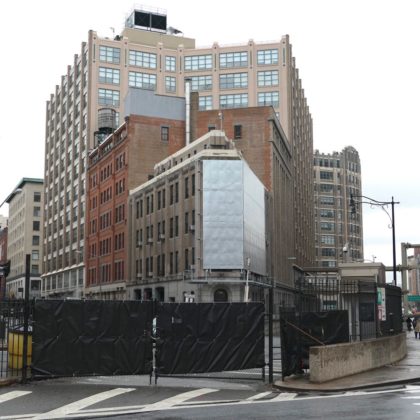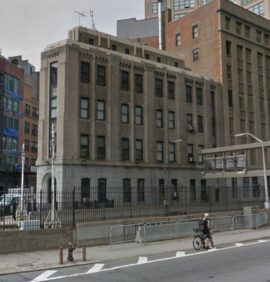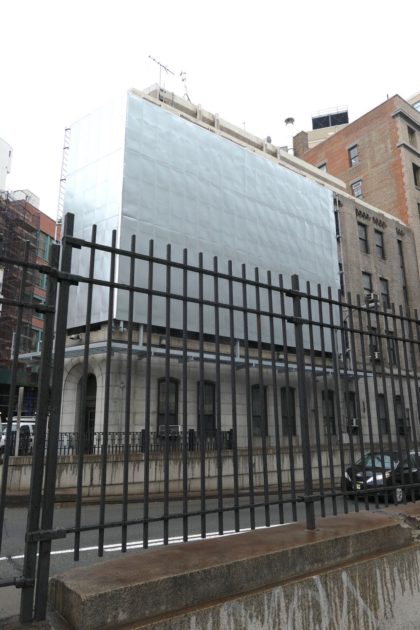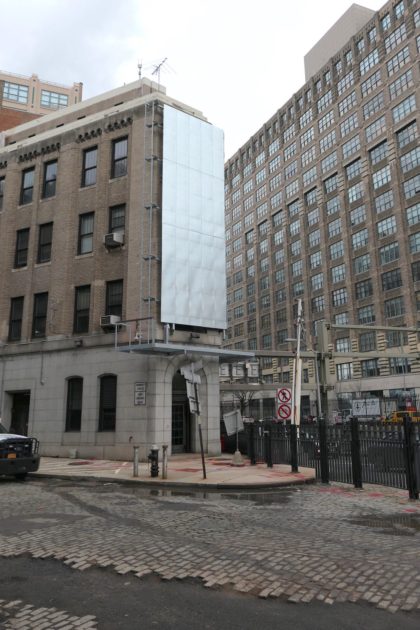Nosy Neighbor: What’s Happening to This Building on Vestry?
 Do you know why this building at Canal and Vestry is being covered in metal? —N.
Do you know why this building at Canal and Vestry is being covered in metal? —N.
A rep for the Port Authority of New York and New Jersey, which owns 4-10 Vestry and uses it as the Holland Tunnel Emergency Garage, is “installing an exterior billboard as a way to generate revenue from advertising for our transportation program.”
 The next logical question is whether the organization is allowed to do such a thing, since the building falls within the Tribeca North Historic District. The answer is yes, because the Landmarks Preservation Commission has no authority over the Port Authority.
The next logical question is whether the organization is allowed to do such a thing, since the building falls within the Tribeca North Historic District. The answer is yes, because the Landmarks Preservation Commission has no authority over the Port Authority.
A side note: When I ran this by James, he pointed out that buildings owned by New York State are subject to the New York State Historic Preservation Act of 1980, Section 14.09. “Most, if not all, New York City Landmarks are either listed on the State Register or eligible for listing, so I doubt this would have passed muster here if the building were state-owned (and not owned by the Port Authority),” he said.
Above right is a photo taken by Google Maps last September. And here’s the summary about 4-10 Vestry from the LPC’s designation report:
This four-story, triangular-shaped office building, located at the eastern end of the block, has approximately ninety-foot facades on Vestry Street and Canal Street. Five small buildings at the eastern end of the block were demolished in 1925 in conjunction with the widening of Canal Street and Varick Street prior to the construction of the Holland Tunnel. The building was designed by Erling Dure for the New York State Bridge and Tunnel Commission and the New Jersey Interstate Bridge and Tunnel Commission in 1926; Dure also designed the tunnel ventilation buildings.
The building has a one-story granite-faced base which on the Canal Street facade has segmentally-arched windows with industrial steel sash. The round-archway in the angled corner bay has a multi-light bronze door in a bronze surround with “The Holland Tunnel” inscribed on the lintel. The Vestry Street base has a variety of openings, including three vehicular bays with segmentally-arched heads. The upper facades of patterned brown brick are divided by wide and narrow pilasters into single window bays terminated by limestone corbel tables. The roofline is a series of setbacks, edged with limestone bands, which culminate in a brick penthouse with a limestone parapet. The windows have four-over-four industrial sash. The building remains in use at the Holland Tunnel Administration Building.
Got a question? Email tribecacitizen@gmail.com.

 Previous Nosy Neighbor posts:
Previous Nosy Neighbor posts:
• What’s opening at 280 Broadway?
• Why are construction fences always green?
• What Gives With This Window at 1 World Trade Center?
• What’s opening at Le District?
• What are the Hudson Tubes?
• What’s this Citi Bike pole?
• Is there a Moore Street?
• What are those holes in 1 World Trade Center?
• How long will the Bogardus Plaza construction take?
• Why were the trees outside Goldman Sachs cut down?
• When did the signage on 49 Chambers change?
• Why are Tribeca’s street numbers messed up?
• What are those two distinct white bands on 1 World Trade Center’s antenna?
• Why are there hay bales at construction sites?
• What’s that terrace above Le District?
• What’s the white stuff all over Northwest Tribeca?
• Why is the MTA parking buses on Church?
• Is that a Dan Flavin artwork on Worth?
• What’s the deal with 79 and 81 Warren?
• Is work finally starting on 172 Duane?
• Is this parking lot at risk of getting developed?
• Why do buses have backward flags on the windows?
• How do these metal braces work?
• Is Franklin Place really a private street?
• Where are the World Trade Center soldiers based?
• What are these new blue parking signs?
• What’s this thing embedded in the sidewalk?
• Where can I buy photos of old Tribeca?
• Why are these people gathering on Broadway?
• Why does 3 World Trade Center have tailpipes?
• What’s that thing on 60 Hudson’s roof?
• Why is this statue behind a fence?
• Why does 1 World Trade Center look so unfinished at night?
• Why do Brookfield Place’s escalators run that way?
• Why is the Duane Park flag almost always at half-staff?
• Who are the Goatsingers?
• What’s up with the exposed wall at 111 Murray?
• What’s inside the base of 7 World Trade Center?
• What are those panels on the sanitation garage?
• How many fake restaurants are on Seamless?
• Why is 15 Warren painted that way?
• Where do Laughing Man’s profits go?
• When will FiOS come to Tribeca?
• What’s up with 60 Hudson?
• What goes on at 444 Greenwich?
• Why are Goldman Sachs’s lights always on?
• Who’s responsible for the snowflake lights?
• Why does cobblestoning require sprinklers?
• Do newspaper boxes need permits?
• Why does 161 Duane say “Whalebone”?
• What’s the story behind those Harrison townhouses?
• What’s that thing at W. Broadway and Leonard?
• Are buses allowed to idle on Laight?
• Can you recommend any Tribeca picture books?
• Who enforces sidewalk-café regulations?
• What do the characters on 47 Vestry mean?
• Where was the original Blues Bar?
• Can we walk on the West Street medians?
• What’s the story behind the lights at 289 Church?
• What’s the Dream House at 275 Church?
• How come film shoots have a trailer with doors marked “Lucy” and “Desi”?













Is that metal opaque when viewed from the inside looking out? Or is it like those bus decals where it looks opaque from outside but from the inside looking out its not as opaque as one would think.
I don’t think it’s transparent at all.
eek…not much fun for the Port Authority staff working inside.
Not like we turn towards the Holland tunnel exit lanes for “views” but is this what we need… i.e. Yet ANOTHER reason to “hate” New Jersey? (If the Holland tunnel were not enough)
Are those offices behind the metal screen actually occupied?
At least we can gain some satisfaction from knowing a grossly overpaid heavy desk jockey lost his view..
That will be so ridiculously sad and silly to see…
Really Port Authority? You need the $? Damn.
Yes, they really do need the money.
“A detailed report of what Port Authority police earn, compared with what neighboring police departments earn (prepared by the Citizens Budget Commission, a New York City–based public watchdog group), concluded in late 2012 that the Port Authority Police Department, then about 1,700 strong, was already one of the country’s largest and most richly compensated law-enforcement units. At the time, the commission estimated that payments to police constituted about $372 million of the Port Authority’s $406 million public-safety budget. Within New York and New Jersey, only the Nassau and Suffolk County police were paid more. Port Authority senior officers received hourly pay 25 percent to 48 percent above that of senior officers at neighboring municipal police forces. Excluding overtime, pensions, and health benefits, average salaries for rank-and-file police topped $108,157 after six years of service and rose to $117,884 in their 25th year. And unlike officers in New Jersey, Port Authority police don’t contribute to their health insurance, a benefit that can add an amount comparable to 50 percent of their base salaries to their compensation, the CBC reported.
“Supplemental pay made compensation disparities even more pronounced. Port Authority police earned from as much as 14 times the compensation of Jersey City cops to double that of senior NYPD officers. Senior Port Authority police earned 23 percent more than federal agents, and between 32 percent and 57 percent more than New York and New Jersey state troopers. Yet Port Authority police worked fewer hours a year than officers in other police forces, with more days off and shorter tours.
“A consistent factor in this pay gap, according to an analysis of Port Authority compensation between 2008 and 2014 obtained by Open the Books, a watchdog group pressing for greater government transparency, is overtime. ‘Overtime work for police at Port Authority has been out of control for years,’ says Adam Andrzejewski, the group’s founder. Overtime costs at the agency over the past seven years have averaged roughly $300,000 a day, $2 million a week, and more than $100 million a year, much of that earned by the police. City Journal’s Steven Malanga describes a typical example, culled from Open the Books data. Thanks largely to overtime sweeteners provided by the Port Authority, one police lieutenant who retired in 2013 with an annual salary of $129,000 began collecting the following year a lifetime pension of $172,000, or one-third above his base pay. […] According to the Open the Books database, public-safety employees are extremely well compensated, even within Port Authority ranks. Between 2008 and 2014, seven of the top 15 most highly compensated Authority employees worked in security: three police sergeants, two police lieutenants, and two rank-and-file police officers. Their total compensation—which includes base pay, overtime, comp-time cash-in, longevity bonus, shift-differential payments, time-off pay, unspecified retro-payments and one- time payments, FICA pickup payments, and ‘all other payments’—ranged from $324,000 to $403,000.”
https://www.city-journal.org/html/new-york-police-force-doesnt-work-14784.html
One reason this shouldn’t be legal is that its directly above and within view from the Holland Tunnel Approach, which is considered a registered Arterial Highway. Advertising signs within 900 feet and visible from an Arterial Highway are tightly regulated and can only be sized one square foot per linear foot of distance from the sign to the highway. I’d think this will rack up a violation immediately.
I doubt this will get any violation.
DOB enforces the NYC zoning resolution. The arterial highway and advertising rules are part of the NYC zoning resolution. Port Authority is outside the jurisdiction of NYCDOB and the NYC zoning resolution.
Tribeca North is not listed on the National Register. However, I would think that as the PA is a joint governmental agency, authorized by Congress, that it would be subject to the state historic preservation laws. But perhaps there is a loophole here.
Tribeca North is classified by the State Historic Preservation Office as eligible for listing on the State Register and National Register, and so is 4-10 Vestry Street (USN 06101.008683)
Here is the inventory: https://cris.parks.ny.gov/Uploads/ViewDoc.aspx?mode=A&token=prhdKhFQNdQnr7KBh9hCwnfYJo1pcrA8JKrhzU46OYqzHJpLmsFNjmCJvt8Ft0DmnYfLO6OLZJhDPHY4m7wNaPIIfyJlKlztl4jOfgfY9sjKqEpsLY8/MXplR1KVVlGB&q=false
That said, the Port Authority is an “interstate compact,” which by definition requires each state to cede its traditional state sovereignty. That means it is not subject to New York State Historic Preservation law.